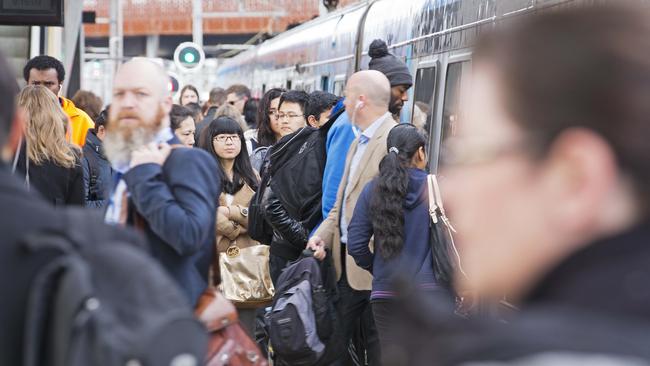Grim forecast: Australian cities at risk of becoming miserable, overcrowded slums
THOUGHT city living couldn’t get any worse? A major new report reveals where Australian cities are headed. And it makes for uncomfortable reading.

AS you slump home tonight on a long commute or in packed public transport, take heart that you are a vital part of the creativity and economic growth of the nation.
Unfortunately you might be an uncomfortable part, because that’s what happens in the struggle to live in a big city: it’s what economic consultants have today called “the ugliness of crowds and crowded places”.
But again take heart, because those economists know how important you are and they want business to invest big to make your life more agreeable — for the sake of national prosperity.
Deloitte Access Economics consultants, in a major report on productivity, warn that without looking after our city folk, urban areas will become the modern-day equivalents of Industrial Revolution slums.
The answer could be technology which eases congestion and liberates city dwellers from those daily nagging frustrations such as buses arriving late.
Deloitte suggests technology is already available that could ease the squeeze, like traffic and transport monitoring that would help us make better use of our time.
“Sensors and actuators can allow remote monitoring and managing of urban infrastructure services, including transport, telecommunications, energy, water, health and emergency services,” according to the Deloitte report.
“This can improve service quality and allow the more efficient allocation of resources, such as by varying tolls to reduce road congestion or making better use of capacity in electricity networks.”
Cities now are the big generators of economic growth through services and what is known as the knowledge or tertiary economy. By 2023 some 80 per cent of the national workforce will be in the tertiary industries, and just four per cent in primary industry and 16 per cent in manufacturing.
And living in high density populations helps inspire the creativity of that workforce.
“Knowledge-intensive services exhibit clustering effects, known as economies of agglomeration,” the report says.
“This simply means that the productivity of knowledge workers rises exponentially when they are in proximity. Their interaction stimulates creativity and innovation — new and different ideas — which in turn drives productivity in the knowledge economy.”
One problem is that this density leads to cramped lifestyles and expensive congestion, which Deloitte forecasts by 2020 could cost $7 billion in Sydney, $5.5 billion in Melbourne, $3 billion in Brisbane, $1.5 billion in Perth and $1 billion in Adelaide.
“It was true of the Industrial Revolution, when the crush of workers in factory towns fuelled overcrowding, squalor and disease.
“Living and working in proximity might stimulate knowledge workers to greater heights of creativity and innovation, but it can also drive them to distraction on overcrowded roads and public transport, or to despair as the cost of desirable housing rises faster than average incomes.”
It notes problems such as air, water and noise pollution; waterways festooned with litter; heavy traffic; parks and gardens unsafe after dark. And loneliness.
“More people are expected to live alone in the future: the number of single-person households in Australia is predicted to rise from around two million in 2009 to 3.1 million in 2031,” it said.
Deloitte urge business to invest in improving city lifestyles, because it could improve their bottom line.
“Could it be that making places flourish pays off at least as much for businesses as it does for individuals, communities and governments?,” it said.
“Could economies of agglomeration be the greatest source of increasing returns, rising productivity and living standards since the Industrial Revolution?
“If the key to rising productivity in the knowledge economy is innovation, and innovation stems from the creative potential released by agglomeration, every person and organisation has an enlightened self-interest in helping to create places that flourish rather than languish.”




